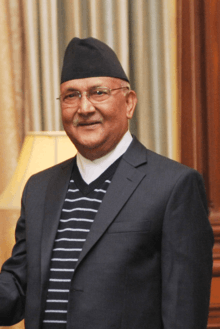Prime Minister of Nepal
The prime minister of Nepal (Nepali: नेपालको प्रधानमन्त्री) is the leader of the executive body (i.e. the Government of Nepal). The prime minister is the head of the Council of Ministers of Nepal. He/she should be member of the House of the Representatives i.e. the Pratinidhi Sabha. The prime minister is the senior-most member of cabinet in the executive of government in a parliamentary system. The prime minister selects and can dismiss members of the cabinet; allocates posts to members within the government; and is the presiding member and chairperson of the cabinet.
| Prime Minister
नेपालको प्रधानमन्त्री | |
|---|---|
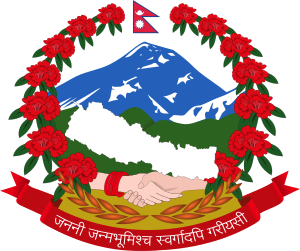 | |
| Style | The Right Honourable (formal) His Excellency (diplomatic) |
| Status | Head of government |
| Abbreviation | P.M. प्र.म. |
| Member of |
|
| Reports to |
|
| Residence | Baluwatar, Kathmandu[1] |
| Seat | Singha Durbar, Kathmandu |
| Appointer | President of Nepal |
| Term length | At the pleasure of the president; Pratinidhi Sabha term is 5 years unless dissolved sooner; No term limits specified |
| Inaugural holder | Bhimsen Thapa(disputed) |
| Formation | 25 December 1843 |
| Deputy | Deputy Prime Minister of Nepal (multiple) |
| Salary | NPR 77,800.00 (basic monthly pay)[2] |
| Website | www |
 |
|---|
| This article is part of a series on the politics and government of Nepal |
Executive:
Federal Parliament:
Judiciary: |
|
Administrative divisions
|
|
|
|
Related topics |
|
|
The federal cabinet headed by the prime minister is appointed by the president of Nepal to assist the latter in the administration of the affairs of the executive. The prime minister has to enjoy the confidence of a majority in the Pratinidhi Sabha and shall resign if they are unable to prove majority when instructed by the president.
The residence of the prime minister of Nepal is in Baluwatar, Kathmandu.[1][3] The seat of the prime minister is Singha Darbar since the time of Chandra Shamsher Jang Bahadur Rana.[4] The basic monthly salary of the prime minister of Nepal is NPR 77,280.[2] The prime minister of Nepal has a term limit of 5 years.
The current prime minister is KP Sharma Oli, since 15 February 2018.[5]
History
Introduction
The position of prime minister of Nepal (Nepali: नेपालको प्रधानमन्त्री, romanized: Nēpālakō pradhānamantrī) in modern form was called by different names at different times of Nepalese history. At the time of the Shah dynasty, either Chautariya, Kaji or Mulkajis (Chief Kajis) served the function of prime ministers. In 1806, the position of Mukhtiyar was created by Rana Bahadur Shah which carried executive powers of nation.[6] Mukhtiyar is formed from two words: Mukhya and Akhtiyar. Mukhya means Chief[7] and Akhtiyar means Authority.[8] Altogether it means the "Executive Head of the State". Mukhtiyar held the position of Executive Head till adoption of title of Prime Minister in 1843 A.D.[9] The first Mukhtiyar to title himself as Prime Minister, as per the British convention, was the last Mukhtiyar Mathabar Singh Thapa.[9] Mathabar Singh became Mukhtiyar as well as Prime Minister and Commander-In-Chief of the Nepalese army in November 1843 [10] by the declaration of second queen of Rajendra, Queen Rajya Laxmi Devi.[11][note 1] During the Rana dynasty, the position of Prime Minister was hereditary and the officeholder held additional titles — Maharaja of Lambjang and Kaski, Supreme Commander-in-Chief of Nepal and Grand Master of the Royal Orders of Nepal.
Opinion on First Prime Minister: Damodar Pande or Bhimsen Thapa
Mukhtiyar Bhimsen Thapa was the first person to be referred to as Prime Minister by the British.[9] Similarly, historian Chittaranjan Nepali writes that the first institution to hold all state powers was the position of Mukhtiyar which was established after King Rana Bahadur Shah returned to Nepal from Varanasi. However, historians believe that Kaji Damodar Pande was the first person to hold power as a Prime Minister as the modern system of administration originated in Nepal with the emergence of Damodar Pande.[13] Damodar Pande was the most influential Kaji since the fall of regent Chautariya Bahadur Shah of Nepal from central power in April 1794 by his newly active nephew, King Rana Bahadur Shah.[14] During the minority of the King Girvan Yuddha, Damodar Pande took over the administration as Mulkaji, or prime minister (1799-1804), with complete control over administration and the power to conduct foreign affairs. He set a significant precedent for later Nepalese history, which has seen a recurring struggle for effective power between king and prime minister. The main policy of Damodar Pande was to protect the young king by keeping his unpredictable father in Banaras and to play off against each other the schemes of the retired king's wives. By 1804 this policy had failed. The former king engineered his return and took over as mukhtiyar. [15][16]
1768-1806
The character of government in the Kingdom of Nepal was driven from consultative state organ of the previous Gorkha hill principality, known as Bharadar.[17][note 2] These Bharadars were drawn from high caste and politically influential families. For instance; Thar Ghar in previous Gorkha hill principality. The nobility of Gorkha was mainly based from Chhetri families and they had a strong presence in civil administration affairs.[18] All of the Prime Minister of Nepal between 1768 and 1950 were Chhetris with the exception of Ranga Nath Poudyal, being a Brahmin.[19] Bharadars formed a consultative body in the kingdom for the most important functions of the state as counsellors, ministers and Diplomats.[17] There was no single successful coalition government as court politics were driven from large factional rivalries, consecutive conspiracies and ostracization of opponent Bharadar families through assassination rather than legal expulsion.[17] Another reason was the minority of the reigning King between 1777 and 1847 that led to establishment of anarchial rule.[20] The government was stated to have controlled by regents, Mukhtiyars and alliance of political faction with strong fundamental support.[20] At the end of the 18th century, the central politics was regularly dominated by two notable political factions; Thapas and Pandes.[20] Per historians and contemporary writer Francis Hamilton, the government of Nepal[note 3] comprised
- 2 Chautariyas
- 4 Kajis
- 4 Sirdar/Sardars
- 2 Subedars
- 1 Khazanchi
- 1 Kapardar.[17]
Per historian Dilli Raman Regmi, the states the government of Nepal were
- 4 Chautariyas
- 4 Kajis
- 4 Sirdar/Sardars.[17] Later, the number varied after King Rana Bahadur Shah abdicated his throne to minor son in 1799.[17]
Fall of Bahadur Shah and rise of Damodar Pande
In 1794, King Rana Bahadur Shah came of age and his first act was to re-constitute the government such that his uncle, Prince Bahadur Shah of Nepal, had no official part to play.[21][14] Rana Bahadur appointed Kirtiman Singh Basnyat as Chief (Mul) Kaji among the newly appointed four kajis though Damodar Pande was the most influential Kaji.[14] Kirtiman had succeeded Abhiman Singh Basnyat as Chief Kaji[22] while Prince Bahadur Shah was succeeded as Chief (Mul) Chautariya by Prince Ranodyot Shah, then heir apparent of King Rana Bahadur Shah.[14] Kajis had held the administrative and executive powers of the nation after the fall of Chief Chautariya Prince Bahadur Shah in 1794. Later, Kirtiman Singh was secretly assassinated on 28 September 1801, by the supporters of Raj Rajeshwari Devi[23] and his brother Bakhtawar Singh Basnyat, was then given the post of Chief (Mul) Kaji.[24] During Bakhtawar's tenure as the Mul Kaji, on 28 October 1801, the Treaty of Commerce and Alliance was signed between Nepal and East India Company.[25] Queen Rajrajeshwari was restored as regent of Nepal on 17 December 1802.[26][27] On subsequent February, Damodar Pande was appointed by Queen Rajrajeshwari as Mulkaji (Chief Kaji)[28] as a reward for establishing her regency.[27]
Damodar Pande was the most influential Kaji since the fall of regent Chautariya Bahadur Shah of Nepal from central power in April 1794 by his newly active nephew, King Rana Bahadur Shah.[14] By 1797, his relationship with his uncle, who was living a retired life, and who wanted to seek refuge in China on the pretext of meeting the new emperor, had deteriorated to the extent that he ordered his imprisonment on 19 February 1797 and his subsequent murder on 23 June 1797. Similarly, in mid-1795, he became infatuated with a Maithil Brahmin widow, Kantavati Jha, and married her on the oath of making their illegitimate half-caste son (as per the Hindu law of that time) the heir apparent, by excluding the legitimate heir Prince Ranodyot Shah who was born from his previous marriage with a high caste Chhetri, Queen Subarna Prabha Devi.[note 4][14][30] Such acts earned Rana Bahadur notoriety both among courtiers and common people, especially among Brahmins.[14][31] After the inevitable death of Kantavati, Rana Bahadur suffered a mental breakdown during which he lashed out by desecrating temples and cruelly punishing the attendant physicians and astrologers.[32] He then renounced his ascetic life and attempted to re-assert his royal authority.[33] This led to a direct conflict with almost all the courtiers who had pledged a holy oath of allegiance to the legitimate king Girvan Yuddha Bikram Shah. This conflict eventually led to the establishment of a dual government and to an imminent civil war, with Damodar Pande leading the military force against the dissenting ex-king and his group.[34][33] Since most of the military officers had sided with Damodar Pande, Rana Bahadur realized that his authority could not be re-established; and he was forced to flee to the British-controlled city of Varanasi in May, 1800.[34][33]
Fall of Damodar and rise of Bhimsen Thapa
As soon as they received the news, Rana Bahadur and his group proceeded towards Kathmandu. Some troops were sent by Kathmandu Durbar to check their progress, but the troops changed their allegiance when they came face to face with the ex-King.[35] Damodar Pande and his men were arrested at Thankot where they were waiting to greet the ex-King with state honors and take him into isolation.[35][36] After Rana Bahadur's reinstatement to power, he started to extract vengeance on those who had tried to keep him in exile.[37] He exiled Rajrajeshwari to Helambu, where she became a Buddhist nun, on the charge of siding with Damodar Pande and colluding with the British.[38][39] Damodar Pande, along with his two eldest sons, who were completely innocent, was executed on 13 March 1804; similarly some members of his faction were tortured and executed without any due trial, while many others managed to escape to India.[note 5][40][39] Rana Bahadur also punished those who did not help him while in exile. Among them was Prithvipal Sen, the king of Palpa, who was tricked into imprisonment, while his kingdom forcefully annexed.[41][42] Subarnaprabha and her supporters were released and given a general pardon. Those who had helped Rana Bahadur to return to Kathmandu were lavished with rank, land, and wealth.Bhimsen Thapa was made a second kaji; Ranajit Pande, who was the father-in-law of Bhimsen's brother, was made the Mulkaji; Sher Bahadur Shah, Rana Bahadur's half-brother, was made the Mul Chautariya; while Rangnath Paudel was made the Raj Guru (royal spiritual preceptor).[41][43]
After almost two-year, all of a sudden Rana Bahadur was made Mukhtiyar (chief authority) and Bhimsen tried to implement his schemes through Rana Bahadur.[44] Bhimsen had also secretly learned of a plot to oust Rana Bahadur.[45] Tribhuvan Khawas (Pradhan), a member of Sher Bahadur's faction, was imprisoned on the re-opened charges of conspiracy with the British that led to the Knox's mission, but for which pardon had already been doled out, and was ordered to be executed.[46][47] Tribhuvan Khawas decided to reveal everyone that was involved in the dialogue with the British.[46][47] Among those implicated was Sher Bahadur Shah.[46][47] On the night of 25 April 1806, Rana Bahadur held a meeting at Tribhuvan Khawas's house with rest of the courtiers, during which he taunted and threatened to execute Sher Bahadur.[48][49] At around 10 pm, Sher Bahadur in desperation drew a sword and killed Rana Bahadur Shah before being cut down by nearby courtiers, Bam Shah and Bal Narsingh Kunwar, also allies of Bhimsen.[50][51] The assassination of Rana Bahadur Shah triggered a great massacre in Bhandarkhal (a royal garden east of Kathmandu Durbar) and at the bank of Bishnumati river.[52][53] That very night member of Sher Bahadur's faction – Bidur Shah, Tribhuvan Khawas, and Narsingh Gurung – and even King Prithvipal Sen of Palpa, who was under house arrest in Patan Durbar, were swiftly rounded up and killed in Bhandarkhal.[54][55] Bhimsen managed to kill everyone who did not agree with him or anyone who could potentially become a problem for him in the future. In this massacre that lasted for about two weeks, a total of ninety-three people (16 women and 77 men) lost their lives.[54][56]
Almost one and half months before the massacre, upon Bhimsen's insistence, Rana Bahadur, then 31 years old, had married a 14-year-old girl named Tripurasundari on 7 March 1806, making her his fifth legitimate wife.[note 6][59] Taking advantage of the political chaos, Bhimsen became the Mukhtiyar (1806–37), and Tripurasundari was given the title Lalita Tripurasundari and declared regent and Queen Mother (1806–32) of Girvan Yuddha Shah, who was himself 9 years old.[60] Thus, Bhimsen became the first person outside the royal household to hold the position of the Mukhtiyar. All the other wives (except Subarnaprabha[61]) and concubines of Rana Bahadur, along with their handmaidens, were forced to commit sati.[56][62] Bhimsen obtained a royal mandate from Tripurasundari, given in the name of King Girvan, commanding all other courtiers to be obedient to him.[60] Bhimsen further consolidated his power by disenfranchising the old courtiers from the central power by placing them as administrators of far-flung provinces of the country. The courtiers were instead replaced by his close relatives, who were mere yes-men.[63] On the spot where Rana Bahadur Shah drew his last breath, Bhimsen later built a commemorative Shiva temple by the name Rana-Mukteshwar.[64]
Thapadom and subsequent transition; 1806-1846
Bhimsen Thapa ruled for 31 years as Mukhtiyar and implemented large number of reforms in agriculture, forestry, trade and commerce, judiciary, military, communications, transportations, slavery, human trafficking and other social evils in his premiership. During Bhimsen's prime ministership, the Gurkha empire had reached its greatest expanse from Sutlej river in the west to the Teesta river in the east. However, Nepal entered into a disastrous Anglo-Nepalese War with the East India Company lasting from 1814–16, which was concluded with the Treaty of Sugauli, by which Nepal lost almost one-third of its land. It also led to the establishment of a permanent British Residency. The death of King Girvan Yuddha Bikram Shah in 1816 before his maturity, and the immature age of his heir, King Rajendra Bikram Shah, coupled with the support from Queen Tripurasundari (the junior queen of Rana Bahadur Shah) allowed him to continue to remain in power even after Nepal's defeat in the Anglo-Nepalese War.
Rana regime; 1846-1951
The Rana regime founded by Jung Bahadur Rana began an autocratic and totalitarian rule.
Democratic rule and subsequent Panchayat rule; 1951-1990
Only a handful of Nepalese prime ministers have carried a democratic mandate. The first elected prime minister was B. P. Koirala, in 1959. After he was deposed and imprisoned in 1960, King Mahendra established the Panchayat system and the country did not have a democratic government until 1990.
Constitutional Monarchy; 1990-2008
The country became a constitutional monarchy after the Jana Andolan movement.
Federal Democratic Republic; 2008-present
The monarchy was abolished on 28 May 2008 by the 1st Constituent Assembly, and the country was declared a federal democratic republic.
Powers
Section 75 of 2015 Constitution of Nepal vests the executive power of federal government of Nepal on Council of Ministers of Nepal. Per Section 76, the prime minister is the chairman of Council of Ministers of Nepal and thus exercises executive power collectively with the mandate of the council of ministers. Section 75 is as follows:[65]
- The executive power of Nepal shall rest with the Council of Ministers in accordance with this Constitution and law.
- The responsibility of providing general directives, control and enforcement regarding the governance system of Nepal, by adhering to this constitution and law, shall rest with the Council of Ministers.
- The entire works relating to the federal executive of Nepal shall be done in the name of the Government of Nepal.
- The decision or Order and related certification of credentials as provided for by clause (3) shall be done according to law.
Appointment of the prime minister
The appointment process of the prime minister of Nepal as per Part 7 Section 76 of 2015 Constitution of Nepal is as follows:[66]
- The president shall appoint the parliamentary party leader of the political party with the majority in the House of Representatives as a prime minister, and a Council of Ministers shall be formed in his/her chairmanship.
- If there is not a clear majority of any party according to clause (1), the president shall appoint as Prime Minister the member of the House of Representatives who can have the majority with the support of two or more political parties represented in the House of Representatives.
- If there is a situation wherein it is not possible to make the appointment of the prime minister as provided for in clause (2) within 30 days of the final result of the election of the House of Representatives, or if the appointed prime minister, as provided for in clause (4), fails to receive a vote of confidence, the president shall appoint the leader of the party with the highest number of members in the House of Representatives as the prime minister.
- The prime minister appointed according to clause (2) or (3) shall have to receive the vote of confidence of the House of Representatives within 30 days of his/her appointment.
- If a prime minister appointed according to clause (3) fails to receive a vote of confidence pursuant to clause (4), the president shall appoint a member as Prime Minister, who produces bases that he/she may win the vote of confidence of the House of Representatives as provided for in clause (2).
- The prime minister appointed according to clause (5) shall have to get the vote of confidence according to clause (4).
- If the prime minister appointed according to clause (5) fails to get the vote of confidence or if any member fails to be appointed as prime minister, the president shall, on the recommendation of Prime Minister, dissolve the House of Representatives and fix a date to conduct another election within six months.
- The procedure regarding the appointment of the prime minister shall have to be completed within 55 days after the post of the prime minister falls vacant, or the announcement of the final results of the election of the House of Representatives according to this Constitution.
- The president shall, on the recommendation of the prime minister, form a council of ministers consisting of members not exceeding twenty-five in number from among the members of the Federal Parliament on the basis of the principle of inclusion.
- The prime minister and the ministers shall be collectively accountable to the Federal Parliament, and, a minister shall be personally accountable to the prime minister for the works of his/her ministry, and also to the Federal Parliament.
Removal
The appointment process of the prime minister of Nepal as per Section 77 (1) of 2015 Constitution of Nepal is as follows:[67]
The prime minister shall cease to hold office in the following circumstances:
- If he/she tenders written resignation to the president,
- If a vote of confidence fails to be approved according to Article (100), or a motion of no confidence is passed,
- If he/she ceases to be a member of the House of Representatives,
- If he/she dies.
Furthermore, the Section 77 (3) states: If the prime minister ceases to hold the office according to clause (1), the same council of ministers shall continue to work until another council of ministers is constituted, provided that, in the case of the death of the prime minister, the senior most minister shall continue to act as Prime Minister until a new prime minister is appointed.
List of prime ministers of Nepal
Living former prime ministers
As of August 2020, there are following living former prime ministers:
| Prime ministers | Term of office | Date of birth | Portrait |
|---|---|---|---|
| Lokendra Bahadur Chand | 1983–1986; 1990-1990; 1997-1997; 2002-2003 | February 15, 1940 | |
| Sher Bahadur Deuba | 1995–1997; 2001-2002; 2004–2005; 2017-2018 | June 13, 1946 | 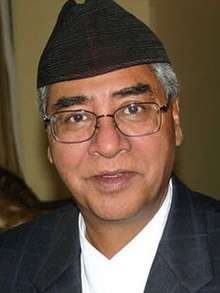 |
| Prachanda (Pushpa Kamal Dahal) | 2008-2009; 2016-2017 | December 11, 1954 | 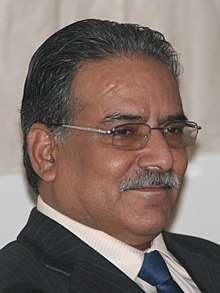 |
| Madhav Kumar Nepal | 2009-2011 | March 6, 1953 | 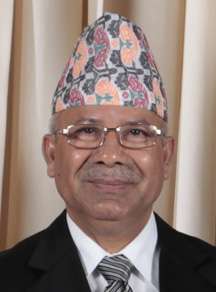 |
| Jhala Nath Khanal | 2011-2011 | May 20, 1950 | 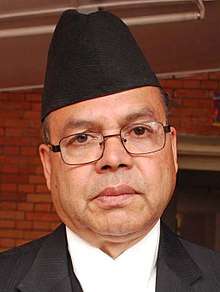 |
| Baburam Bhattarai | 2011-2013 | June 18, 1954 | .jpg) |
| Khil Raj Regmi | 2013-2014 (acting) | May 31, 1949 | .jpg) |
References
Footnotes
- Though he was declared Mukhtiyar and as well as Minister and Commander-In-Chief in November 1843, his appointment letter was issued only on Aswin Badi 7, 1901 (i.e. September 1844). The appointment letter in English translation continues as: From King Rajendra, To Mathbar Singh Thapa Bahadur, son of Nain Singh Thapa, grandson of Ambar Singh Thapa, resident of Gorkha. We hereby appoint you as Mukhtiyar of all civil and administrative affairs throughout our country, as well as Prime Minister, Commander-In-Chief and General with Jagir emoluments amounting to Rs 12,401. Remain in attendance during war and other occasions as commanded by us, be faithful to our salt and utilize the following lands and revenues as your Jagir with due loyalty. (Particulars of lands and revenues follow).[12]
- Bharadar translates as 'bearers of burden of state'.
- Here the government of Nepal can simply be called Bharadari Sabha or Council of Bharadars.
- Rana Bahadur Shah had two legitimate wives before marrying Kantavati. His first wife was Rajrajeshwori Devi with whom he begot one daughter. His second wife was Subarnaprabha Devi with whom he begot two sons, Ranodyot Shah and Shamsher Shah. Ranodyot Shah was the eldest male heir apparent of Rana Bahadur Shah.[29]
- Among those who managed to escape to India were Damodar Pande's sons Karbir Pande and Ranjang Pande.[40]
- While it is generally believed that Tripurasundari was from a Thapa family,[57] Baburam Acharya further conjectured that Tripurasundari was possibly the daughter of Bhimsen's brother Nain Singh Thapa.[58]
Notes
- "PM Deuba shifts to official residence in Baluwatar". thehimalayantimes.com. 19 June 2017. Retrieved 26 March 2018.
- "How much are VIPs, including President and PM, paid monthly?". thehimalayantimes.com. 20 July 2016. Retrieved 26 March 2018.
- "Baluwatar vacated - The Himalayan Times". thehimalayantimes.com. 14 October 2015. Retrieved 26 March 2018.
- "PM's Office - Heritage Tale - ECSNEPAL - The Nepali Way". ecs.com.np. Retrieved 26 March 2018.
- "Left alliance urges President to appoint UML Chair Oli as prime minister". thehimalayantimes.com. 15 February 2018. Retrieved 26 March 2018.
- Nepal, Gyanmani (2007). Nepal ko Mahabharat (in Nepali) (3rd ed.). Kathmandu: Sajha. p. 314. ISBN 9789993325857.
- "English Translation of "मुख्य" - Collins Hindi-English Dictionary". www.collinsdictionary.com. Retrieved 26 March 2018.
- "English Translation of "अख़्तियार" - Collins Hindi-English Dictionary". www.collinsdictionary.com. Retrieved 26 March 2018.
- Kandel, Devi Prasad (2011). Pre-Rana Administrative System. Chitwan: Siddhababa Offset Press. p. 95.
- Regmi 1971, p. 17.
- Regmi 1971, p. 18.
- Regmi 1971, p. 24.
- Regmi 1971, p. 6.
- Pradhan 2012, p. 12.
- Nepal:The Struggle for Power (Sourced to U.S. Library of Congress)
- The Bloodstained Throne Struggles for Power in Nepal (1775-1914) - Baburam Acharya
- Pradhan 2012, p. 8.
- Pahari 1995, p. 632.
- Raj 1996, p. 5.
- Pradhan 2012, p. 9.
- Acharya 2012, p. 14.
- Karmacharya 2005, p. 56.
- Acharya 2012, p. 34.
- Acharya 2012, p. 35.
- Nepal 2007, p. 51; Amatya 1978; Acharya 2012, pp. 35–36.
- Acharya 2012, pp. 36–37.
- Karmacharya 1995, p. 64.
- Pradhan 2012, p. 14.
- Acharya 2012, p. 16.
- Acharya 2012, pp. 16–17.
- Acharya 2012, pp. 17–21.
- Acharya 2012, pp. 26–27.
- Acharya 2012, pp. 28–32.
- Pradhan 2012, p. 13.
- Acharya 2012, pp. 49–55.
- Nepal 2007, p. 56.
- Acharya 2012, pp. 54–57.
- Acharya 2012, p. 57.
- Nepal 2007, p. 57.
- Acharya 2012, p. 54.
- Nepal 2007, p. 58.
- Acharya 2012, pp. 56,80–83.
- Acharya 2012, p. 55.
- Nepal 2007, pp. 60–61.
- Pradhan 2012, p. 27.
- Nepal 2007, p. 61.
- Acharya 2012, p. 63.
- Acharya 2012, pp. 64–66.
- Nepal 2007, p. 62.
- Acharya 2012, p. 67.
- Nepal 2007, pp. 62–63.
- Acharya 2012, pp. 68–71.
- Nepal 2007, pp. 63–64.
- Acharya 2012, p. 70.
- Nepal 2007, p. 63.
- Nepal 2007, p. 64.
- Karmacharya 2005, p. 86.
- Acharya 2012, p. 3.
- Acharya 2012, p. 62.
- Acharya 2012, p. 71.
- Karmacharya 2005, p. 80.
- Acharya 2012, p. 163.
- Pradhan 2012, p. 28.
- Acharya 2012, p. 72.
- "Part 7 Federal Executive, Section 75 Executive power". Nepal Law Commission. Retrieved 2020-06-23.
- "Part 7 Federal Executive, Section 76 Constitution of Council of Ministers". Nepal Law Commission. Retrieved 2020-06-23.
- "Part 7 Federal Executive, Section 77 Vacation of office of Prime Minister and Minister". Nepal Law Commission. Retrieved 2020-06-23.
Books
- Acharya, Baburam (2012), Acharya, Shri Krishna (ed.), Janaral Bhimsen Thapa : Yinko Utthan Tatha Pattan (in Nepali), Kathmandu: Education Book House, p. 228, ISBN 9789937241748
- Nepal, Gyanmani (2007), Nepal ko Mahabharat (in Nepali) (3rd ed.), Kathmandu: Sajha, p. 314, ISBN 9789993325857
- Amatya, Shaphalya (June–November 1978), "The failure of Captain Knox's mission in Nepal" (PDF), Ancient Nepal, Kathmandu (46–48): 9–17, retrieved January 11, 2013
- Pradhan, Kumar L. (2012), Thapa Politics in Nepal: With Special Reference to Bhim Sen Thapa, 1806–1839, New Delhi: Concept Publishing Company, p. 278, ISBN 9788180698132
- Karmacharya, Ganga (2005), Queens in Nepalese Politics: an account of roles of Nepalese queens in state affairs, 1775-1846, Nepal: Educational Publishing House, ISBN 9789994633937
- Pahari, Anup (1995), The Origins, Growth and Dissolution of Feudalism in Nepal: A Contribution to the Debate on Feudalism in Non-European Societies, 4, University of Wisconsin--Madison
- Raj, Prakash A. (1996), Brahmins of Nepal, Nabeen Publications
- Regmi, Mahesh Chandra (1971). Regmi Research Series (PDF). 03. Regmi Research Centre.
- Shaha, Rishikesh (1990), Modern Nepal 1769–1885, Riverdale Company, ISBN 0-913215-64-3
- Shaha, Rishikesh (2001), An Introduction of Nepal, Kathmandu: Ratna Pustak Bhandar
- D.R. Regmi (1975), Modern Nepal, 1, Firma K.L. Mukhopadhyay, ISBN 0883864916
- Wright, Daniel (1877), History of Nepal, Cambridge University Press
